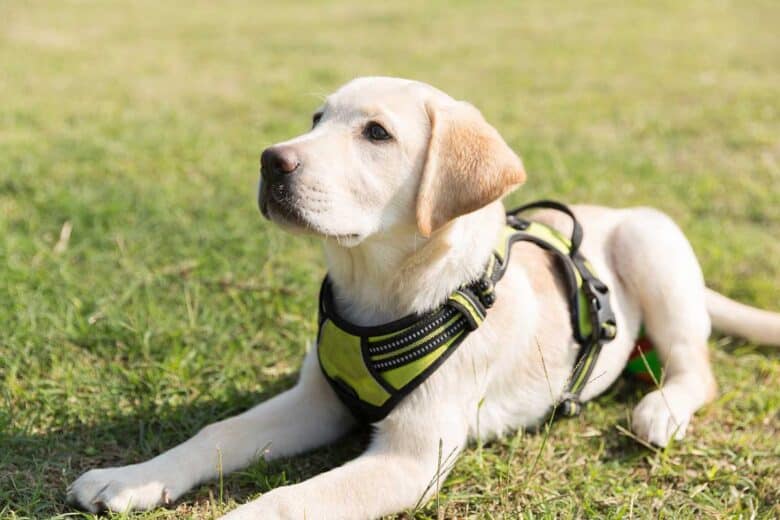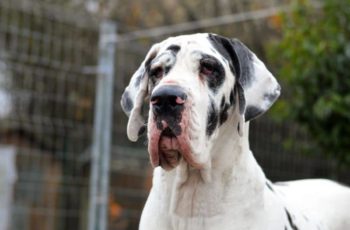This post may contain affiliate links. We may earn money or products from the companies mentioned in this post.
Just because our dogs can’t speak to us and tell us how they are feeling doesn’t mean they can’t communicate with us.
Dogs say so much with their body language that you can understand a lot about what is going on with them by paying close attention to what they do.
One body movement that dogs do regularly and that many dog owners wonder about is when they arch their back, much like a cat.
Like your cat, this might just be your dog having a nice stretch. But it can also be a signal that something isn’t quite right with them on the inside.

Let’s take a look at some of the main reasons why your dog might arch their back, and what other signs you should look out for to determine what exactly is happening with them.
We will also take a quick look at breeds that have a naturally arched back, such as Greyhounds.
Contents & Quick Navigation
Back Arching Behavior In Dogs
Dogs will often arch their back. They might tuck in their stomach and push their hind section up into the air in a classic downward dog pose, or they might curve the center of the spine upwards, in a classic cat stretch.
A lot of the time, if your dog does either of these back arches, they are just having a nice stretch. You will know this is what’s going on because they only do it a couple of times a day, and they revert to normal movement and behavior directly afterward. It is also often accompanied by a big yawn.
They will often do this just after they wake up, and it is to air out the cobwebs, much like when you reach your arms in the air, shrug your shoulders, and curve your back to release a bit of tension.
Your dog may also adopt the cat stretch pose when they are scared. This is a strategy to make themselves look bigger in order to scare off any potential threats. You will generally know this is what is going on, as their attention will be completely focussed on the perceived threat.
But if your dog arches their back more often than a couple of times a day, if they hold the arched position for extended periods of time, and if they continue to look uncomfortable within their body after the stretch, perhaps walking differently, these are all signs that there is something wrong.
Dogs may move into this position in order to alleviate pain somewhere in their body. In some way, the arch is allowing them to relieve pressure on wherever the pain is located.
A variety of different pains could be alleviated by a back arch. It can stretch the neck or spine if they are feeling pain in either of these locations. It can change the position of the stomach if that is not feeling well. It can even adjust the weight on their legs if they are the source of the pain.
If your dog is arching their back due to pain, you will probably also notice other signs that things aren’t quite right with your pup, such as stiff walking and hanging their head and tail low.
Let’s take a look at the various issues that might motivate this kind of behavior, and which associated symptoms to look out for to make a diagnosis.
Reasons Your Dog Will Arch Their Back
1. Spinal Misalignment
For most breeds, the ideal dog spine is perfectly straight from shoulder to tail (more on breeds with a different back alignment below). However, it is not uncommon for dogs to be born with spine abnormalities.
Hereditary spinal abnormalities are called kyphosis, and it is an abnormal curvature of the spine, usually centered around the area of the neck or upper back.
If your dog has this condition, they will find that arching their back lessens the pressure on their spine and helps to alleviate pain.
This type of hereditary spinal pain usually kicks in when they are less than one year old, so this should be a concern if you have a younger pup.
Older dogs can also develop spinal misalignments, but this will usually be the result of a trauma that you will probably have observed. This is more likely to be a herniated disk that puts pressure on the spinal nerve, which is extremely painful for your dog.
Your dog will likely display other symptoms that indicate this type of pain. They may have trouble walking and display “drunk walking,” yelp in pain, have difficulty moving their limbs, and be reluctant to jump up and down from things, as this causes them pain.
If you notice this condition in your dog, it is time to speak to your vet to find proper treatment.
2. Back Problems
Spinal problems are also common among senior dogs, mostly as the result of aging and wear and tear.
Older dogs are particularly prone to developing spondylosis deformans, which is basically canine arthritis in the spine.
This occurs when osteophytes, also known as bone spurs, bridge the space along the vertebrae. These spurs often appear along the lumbar spine in the lower back, the thoracic vertebrae in the upper back, or along the lumbosacral spine where the tail starts.
Again, this kind of pain will likely be accompanied by other symptoms, most often difficulty with walking and moving, and a reluctance to jump up and down from things because this causes them pain.
They may also become restless at night, as it will be difficult for them to find comfortable positions in which to sleep.
Get our recommendations for the best orthopedic beds to support older dogs with arthritis here.
3. Abdominal Issues
An arch of the back can be an effective way to relieve abdominal pain, so it may be a sign that your dog is suffering internally.
A number of different problems can cause this kind of pain, including stomach issues such as diarrhea, viral infections, an inflamed or enlarged organ, internal bleeding, or anal sac disorder (the inability to express fluids from the anal glands).
Arching the back can change the position of the internal organs, relieving pressure as needed.
This kind of pain will usually be accompanied by other symptoms such as diarrhea and vomiting, constipation or dry and light-colored stool, or dark-colored stool, the latter generally being a sign of internal bleeding. They may also arch their back while eating, as the digestion process is causing them pain.
Another common abdominal issue is gastric dilatation and volvulus (GDV), which happens when your dog’s stomach becomes bloated with air. It can cause the stomach to rotate within the belly, which can cause your dog significant discomfort and pain.
If this is the problem, the stomach will also probably look significantly larger, and they will probably retch and gag regularly.
All of these conditions are serious and require consulting your vet immediately.
4. Swollen Glands
Male dogs that have been castrated may engage in back arching behavior when excited. This can be caused by the glands at the base of the penis swelling as the dog becomes aroused.
This will usually occur when the male neutered dog is in the vicinity of a female dog. They will arch their back to relieve the pressure on the glands.
You will probably also notice them licking their crotch area.
This is normal and usually passes quickly, but it is worth mentioning to your vet as part of a regular checkup to keep an eye on it over time.
6. Inflamed Prostate
Unneutered dogs may behave in a very similar way when they have an inflamed prostate.
Again, they will arch their pack to relieve the pressure, and you will probably also notice that they are walking very stiffly. They are also likely to have problems urinating and defecating.
Observing Your Pup
Because dogs communicate so much nonverbally, it is important that you pay close attention to their behavior.
Much of their body language is instinctive, and it can be useful to understand as it can help you tell when your pup is feeling happy, frightened, or aggressive.
You can read our complete guide on canine body language here.
But dogs are also creatures of habit, and so what is most important is to watch out for changes in their behavior.
Changes in their eating schedule, their bathroom schedule and stool, in their sleeping schedule, and in their energy levels are all signals that something is not quite right with your pup.
Every dog is different, and what is normal for one breed or even for an individual dog is not the same as for others. This is why looking for changes and abnormality in their behavior is the key to identifying problems.
Dog Breeds With Arched Backs
Some dog breeds are born with natural arches in their back. They have a different spinal curvature to other dog breeds, and this is natural for them as the result of selective breeding.
This natural curvature can either be arched or sloped. Arched makes it look like they are pushing their hind section into the hair, while a sloped back will look like they are pushing their hind section down toward the ground.
The most obvious example of a dog breed with an arched back is the Greyhound, which has quite a pronounced arch that contributes to their speed and agility. The arch allows for flexibility of the spine so that the dog can tuck their rear legs well under their body, which allows them to gallop.
Related breeds such as Scottish deerhounds, Italian Greyhounds, and whippets also have this distinctive back curvature.
Examples of a dog breed with a sloped or sagging back include German shepherds, though this is a new trend as the dog originally had a back that was straight. So, while it is common in the breed, it is actually considered a defect by the American Kennel Club.
While these back arches and slopes are natural for these dogs and nothing to worry about, it does mean that it can be challenging to determine when they are arching their back in order to mitigate pain.
This means that it is even more important to pay attention to their behavior in order to spot these body language signals that something is not quite right.
FAQs
Why Does My Dog Keep Hunching Their Back?
There are many different reasons why your dog might hunch their back, from having a nice stretch to major internal problems. If they are hunching and arching their back more frequently than usual, and they look in continued discomfort rather than refreshed afterward, these are signs that something is wrong.
A variety of medical conditions can be the cause. It could be back pain, abdominal issues, or even prostate concerns.
Your dog will probably also be displaying other symptoms, such as changes in behavior and the consistency of their stool. Take note of these and talk to your veterinarian to find the underlying cause of their problem and appropriate treatment.
How Do I Know If My Dog Has Hurt Their Back?
There are several body language signs that will indicate that your dog has hurt their back. They may arch their back frequently in order to alleviate pressure on certain parts of the spine.
They are also likely to have difficulty walking and moving around, which will likely result in them being less active. Your dog may be reluctant to jump up and down off things, as this also causes them pain.
Should I Be Able To Feel My Dog’s Spine?
It is not uncommon to be able to feel the spine of your dog, and can be an indication that they are at a healthy weight. However, it should never look like their spine is protruding up through the skin of their back. This suggests that they are suffering from malnutrition and are underweight.
If your dog’s spine suddenly seems more pronounced, look out for changes in their eating and bathroom habits to determine why they might be losing weight.
While it is not always pleasant, examining their poop can be one of the most effective ways of figuring out what is going on with them.
You can read more about warning signs to look out for when observing your dog’s poop here.
Can Canine Arthritis Be Cured?
Just like human arthritis, canine arthritis is a progressive condition that cannot be cured. However, there are a number of treatments that can slow down degradation and alleviate pain. Joint supplements based around glucosamine have been shown to be highly effective in managing canine arthritis.
Find our recommendations for the best glucosamine supplements for dogs here. Read our complete guide on Labrador joint health here.
Once a dog begins to show signs of arthritis or other joint problems, a variety of lifestyle changes will be required. You will need to make adjustments to their exercise to prioritize low-impact activities.
You may also need to invest in supportive tools such as an orthopedic bed and a way of elevating their food and water bowls so that they do not need to strain their back to eat and drink.
The Verdict
Dogs often arch their backs, much like cats (and humans), in order to have a nice stretch. This is nothing to worry about if they look and move normally and happily afterward. A quick stretch after waking up is completely normal behavior for a dog.
However, if your dog starts arching their back more often, holding the position for an extended period of time, and continue to look uncomfortable afterward. In this case, your dog is probably taking the arched back position in order to alleviate some kind of discomfort or pain.
There are a variety of things that may provoke this kind of behavior. It could be in pain in the neck, spine, or legs. They might have internal pain in the abdominal region due to stomach conditions, inflammation, or internal bleeding, or they might have problems with their prostate.
In all of these circumstances, your dog will probably show associated symptoms, such as difficulty walking and with other activities, compromised bathroom habits, and sounds of pain.
It is always a signal that you need to talk to your vet to identify the underlying problem to find an appropriate treatment.
Have you dealt with a dog that arches their back in an unhealthy way? What was the problem and the solution? Share your experience with the community in the comments below.
Save To Pinterest

Top Picks For Our Dogs
- BEST PUPPY TOY
We Like: Snuggle Puppy w/ Heart Beat & Heat Pack – Perfect for new puppies. We get all of our Service Dog pups a Snuggle Puppy. - BEST CHEW TOY
We Like: KONG Extreme – Great toy for heavy chewers like our Labrador Retrievers. - BEST DOG TREATS
We Like: Wellness Soft Puppy Bites – One of our favorite treats for training our service dog puppies. - BEST FRESH DOG FOOD
We Like: The Farmer’s Dog – A couple months ago we started feeding Raven fresh dog food and she loves it! Get 50% off your first order of The Farmer’s Dog.
For a list of all the supplies we get for our new service dog puppies check out our New Puppy Checklist on the PuppyInTraining.com blog.
What Does It Mean When My Dog Arches His Back? was last modified: March 22nd, 2021 by


